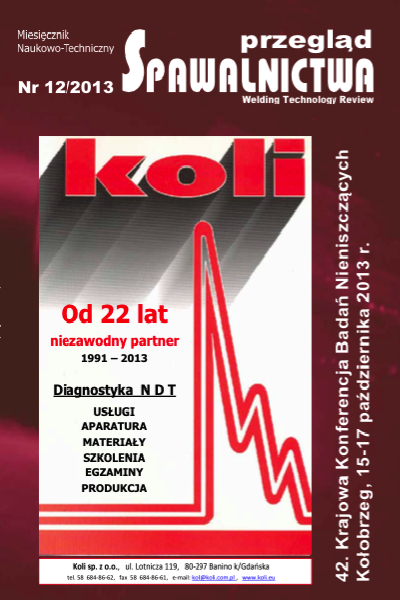Wykorzystanie emisji akustycznej do monitorowania rozwoju pęknięć w konstrukcjach betonowych
Main Article Content
Abstract
Badania laboratoryjne nad zastosowaniem technik nieniszczących do oceny stanu technicznego konstrukcji pracujących w warunkach dużych obciążeń eksploatacyjnych pozwalają istotnie poszerzyć wiedzę o mechanizmach zniszczenia. Szczególną rolę odgrywa w tym aspekcie metoda emisji akustycznej (AT). Artykuł pokazuje możliwości zastosowania tej metody do monitorowania istniejących i rozwijających się mikropęknięć w konstrukcjach betonowych, co stwarza możliwość detekcji powstającego zagrożenia i pozwala uchronić obiekt przed zniszczeniem. Badania w statycznej próbie ściskania rdzeni betonowych z równoczesną rejestracją sygnałów akustycznych pozwoliły określić charakterystyczne parametry sygnałów generowanych przez tarcie oraz tworzenie się oraz rozwój mikropęknięć. Analiza zmian intensywności i aktywności emisji akustycznej umożliwiła wykrycie momentu, w któ- rym istniejące w materiale mikropęknięcia propagują w materiale i doprowadzają do całkowitego zniszczenia konstrukcji. Zebrana w ten sposób charakterystyka akustyczna pozwoli skutecznie monitorować rozwój mikropęknięć podczas badań konstrukcji betonowych.
Monitoring of crack propagation in concrete structures using the acoustic emission method
abstract
Laboratory research using non-destructive techniques for assessment of structures working under heavy operat- ing loads, significantly extends knowledge about the fail- ure mechanisms. A special role in this aspect plays the acoustic emission method (AT). The article shows the possibilities of this method to monitoring of existing and propagating micro-cracks in concrete structures. It allows to detect emerging risk and to protect object from dam- age.
Static compression tests with simultaneous recording of acoustic signals generated in the material helped to determine the characteristic parameters of the signals generated by friction and the formation and propagation of micro-cracks. Analysis of acoustic emission intensity and activity allowed to detect the point at which the existing micro-cracks propagation in the material and lead to destruction of the structure. Identification of the characteristics of acoustic emission signals allows effective monitoring of concrete constructions in service conditions.
Downloads
Article Details
Creative Commons CC BY 4.0 https://creativecommons.org/licenses/by/4.0/
Welding Technology Review (WTR) articles are published open access under a CC BY licence (Creative Commons Attribution 4.0 International licence). The CC BY licence is the most open licence available and considered the industry 'gold standard' for open access; it is also preferred by many funders. This licence allows readers to copy and redistribute the material in any medium or format, and to alter, transform, or build upon the material, including for commercial use, providing the original author is credited.
References
EN 1330-9:2009, non-destructive testing. Terminology. Part 9: Terms used in acoustic emission testing.
EN 15857:2010, non-destructive testing - Acoustic emission - Testing of fibrereinforced polymers - Specific methodology and general evaluation criteria.
I. Malecki, J. Ranachowski: Emisja akustyczna, źródła, metody, zastosowania, Biuro Pascal, Warszawa, 1994.
Masayasu Ohtsu, Toshiro Isoda And Yuichi Tomoda, Acoustic emission techniques standardized for concrete structures J. Acoustic Emission, 25 (2007)
